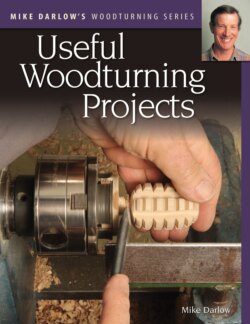Читать книгу Mike Darlow's Woodturning Series: Useful Woodturning Projects - Mike Darlow - Страница 31
2.3.1 Detail gouge noses
ОглавлениеThere’s less tear-out if you cut cove bottoms with the gouge’s active edge (the length of edge actively cutting) presented at about 45° side rake (skewed at about 45° to the velocity of the wood about to be cut). Therefore of the two gouge noses shown in figure 2.8, the ladyfinger nose at the top is far better than the fingernail nose at the bottom. However if you grind a basic ladyfinger nose like that in figure 2.8 on a bowl gouge or on a blade with a cross section similar to that shown in figure 2.7, you’ll only be able to cut narrow coves a little deeper than semicircular. To cut much deeper narrow coves without lessening the blade’s cross section back from the nose, you need to reduce:
• the sharpening angle
• the height of the flanges in the nose region
• the width of the nose
The effectiveness of reducing the sharpening angle and the height of a blade’s flanges at the nose end of the blade is explained in figure 2.9. Nose grindings which enable the flange height and nose width are shown in figure 2.10. The three types of resulting gouge noses are shown in figures 2.11 and 2.12.
Figure 2.9 Showing that the depth of cove which a gouge can cut without fouling the cove rim increases as the sharpening angle decreases. Therefore sharpen detail gouges at 25°. Also, the smaller the sum of the flange height and blade thickness beneath the bottom of the flute, the deeper the cove which can be cut.
Figure 2.10 Grinding noses on stiff blades to allow the tools to cut deep, narrow coves. The unground cross section has a mauve fill. The outlines with the palest, medium and darkest orange fills represent respectively grinding down the flanges, grinding away nose width, and grinding the nose’s cross section below the bottom of the flute to a semicircle. This third grinding operation is usually optional because the area of the blade which is usually being supported by the toolrest is well back from the nose.
Figure 2.11 A 9.5-mm-wide gouge blade with a flute radius of 1.75 mm, a blade cross section similar to that in figure 2.7. The nose has been ground as shown on the right-hand side of figure 2.10.
The grinding to reduce nose flange heights and widths can be done on a conventional bench grinder with the blade’s axis parallel to the velocity of the grinding wheel’s periphery or parallel to the grinder’s spindle.
Figure 2.12 The noses of two adequately stiff, small-fluted gouges sharpened with ladyfinger noses, and a cove cut by each.
Left, the flute radius of the modified bowl gouge is 2.5 mm, and the cove is 5.5-mm-wide and 9-mm-deep. Right, the blade width of the inserted bit is 6 mm, and its flute radius is 1.5 mm. The cove is 4.5-mm wide and 5-mm deep. The flat on the top of the shaft in which the bit is housed results from a hammer blow to lock the bit into the bored hole in the shaft.
